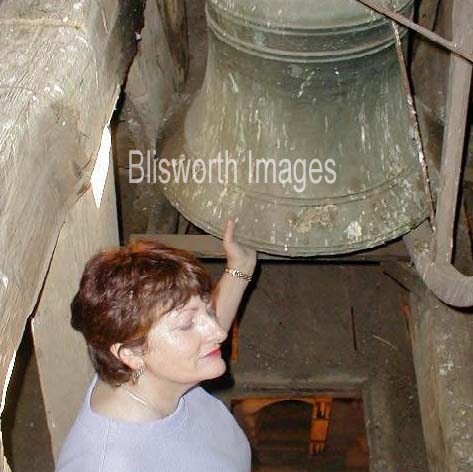
BELLS AT BLISWORTH CHURCH by G. Freeston (1965)
Back to the bells restoration section
There appears to have been a complete overhaul of the bell frame and the bells in 1624, which date appears on one of the massive oaken beams now supporting (rather precariously) the frame on which our present five bells hang. At that time, 1624, the second and third bells were most probably added, for both these bells are inscribed with the date 1624.
In 1626 the smallest bell was recast, and yet again in 1758. Number 4 bell was recast in 1758 and number 5 bell, our largest at 42” diameter, was recast in 1663 and again in 1758. In 1700 it is recorded that there was a Priest’s bell which carried the date 1635 but no mention of this bell appears at a later date.
[recorded in the churchwardens account book is an expenditure of £94 to J. Taylor and Company to repair a cracked fourth bell]
All five bells carry interesting inscriptions. Since the early days the custom of inscribing the church bells seems to have been fairly common, although the pre-Reformation bells carried the simple name of a saint and perhaps the name of the founder. These early inscriptions are usually in stately Gothic capitals and in Latin - the language of the medieval church. The Reformation introduced many changes in connection with bells. The capitals gradually gave way to clumsy Roman letters for the inscriptions. English, although it did not supplant Latin, gained a full share of use on the bells. The old forms gave place to mottos of a reverent character which soon, however drifted in many places into doggerel rhyme, stupid, frivolous and thoroughly out of place or into a bare list of names of vicars and churchwardens.
Following are the inscriptions on our five bells:
Bell 1, “TINNITVS RAPIDOS SCINT ILLANS SPARGO PER AVRAS”
Translates: Sparkling scatter through the air with rapid sounds.
THOS AEYRE ME FECIT 1756
previously: R. A. Bartholemew Atton made me 1626
Bell 2, BARTHOLEMEW ATTON MADE ME 1624 RA
Bell 3, BARTHOLEMEW ATTON MADE ME RA 1624
Bell 4, “GOD SAVE OUR QVEEN AND PRESARVE HER PECE”
Henry Bagly M me 1713 Richard Barwell. John Burgess. Churchwardens.
Bell 5, “VLTERA CVRETVM PLVUSVS CORYBANTUAQVE AERA”
Translates: beyond the applause of the Curetes, and the cymbals of Corybantes.
Thos. Eayre. Horologicvs. William Plowman and William Herbert
Hierophylacebvs A.D. 1758
previously: George Bland and John Plowman churchwardens
Henry Bagly made me 1663.
________________________________________________________
Bell 1 was cast in the reign of George II, bells 2 and 3 in the reign of James I and bell 4 in the reign of Queen Anne.
Bell 1, up to the beginning of WW II, was rung daily at twelve noon and was commonly called the “Dinner Bell”, thanks to the sexton’s good time keeping. This practice was very welcome in the days before radio and time signals.
The bell 5 inscription calls for some explanation: In Cretan mythology the Curetes were demi-gods armed with weapons of brass, to whom the new born child Zeus was given for safe keeping. They drowned his cries by striking their spears against their shields. The Corebantes were the mythical attendants of the Phrygian goddess Phea Cybelle, who was supposed to accompany the goddess with wild dances and intoxicating music while she wandered by torchlight over the forest-clad mountains.
Both bells 1 and 5 were cast by bell founder Thos. Aeyre, of Kettering, and he probably had stock (meaningless?) phrases to be applied to his bells. Many founders incl. Aeyre were also clockmakers - hence Horologicus after his name.
Mention of Bartholemew Atton, the founder of bells 2 and 3, is first made at Buckingham in 1604. The latest dated bells by this man are our own in Blisworth. Little otherwise is known of this founder. (That was the case in 1965 but when Phil Cahill and his team organised the refurbishment of the bells, Barbara Atton, the founder's descendant, (photo below) came to visit as they were taking down the bells. She has been doing a lot of research on Bartholomew and is more than willing to part with any information required. Any interest will be passed on through this website.
Bell 4, together with its quaint spelling of the inscription, was the product of Henry Bagly of Chacombe near Banbury. Chacombe was a forest village, hence the good supply of timber to melt the bronze. A member of the Bagly family also advertised: “..the said Henry Bagly if desired will cast any ring or rings of bells in the town where they belong..” The practice was common of casting and tuning bells in a workshop set up in the churchyard. The roads were in such a bad condition that they prohibited the cartage of such heavy objects for any great distance.
From the earliest of times bells were christened, but from the time of the reformation such christening got a little out of hand. Gilbert White tells of when the new bells were brought to Selbourne, the treble bell was fixed upside down and filled with punch. This form of profane christening has fortunately become a thing of the past and dedications have taken their place.
The English have for so many generations enthusiastically practiced bell
ringing that long ago we became known to our overseas visitors as the “Ringing
Island”. There are recorded cases, however, where ringing of bells was not
always acceptable. In one case the town stated that bell ringing turned all
drink sour.
